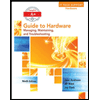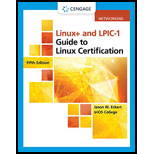
EBK COMPUTER SCIENCE: AN OVERVIEW
12th Edition
ISBN: 8220102744196
Author: BRYLOW
Publisher: PEARSON
expand_more
expand_more
format_list_bulleted
Concept explainers
Question
Chapter 4, Problem 42CRP
Program Plan Intro
Transport layer:
The transport layer accepts the message that is sent by the application layer. This layer is the second layer from the top in the internet software hierarchy. The transport layer also divides a long message into various small message segments to meet the maximum size set by each protocol.
Expert Solution & Answer
Want to see the full answer?
Check out a sample textbook solution
Students have asked these similar questions
Specifications: Part-1Part-1: DescriptionIn this part of the lab you will build a single operation ALU. This ALU will implement a bitwise left rotation. Forthis lab assignment you are not allowed to use Digital's Arithmetic components.IF YOU ARE FOUND USING THEM, YOU WILL RECEIVE A ZERO FOR LAB2!The ALU you will be implementing consists of two 4-bit inputs (named inA and inB) and one 4-bit output (named
out). Your ALU must rotate the bits in inA by the amount given by inB (i.e. 0-15).Part-1: User InterfaceYou are provided an interface file lab2_part1.dig; start Part-1 from this file.NOTE: You are not permitted to edit the content inside the dotted lines rectangle.Part-1: ExampleIn the figure above, the input values that we have selected to test are inA = {inA_3, inA_2, inA_1, inA_0} = {0, 1, 0,0} and inB = {inB_3, inB_2, inB_1, inB_0} = {0, 0, 1, 0}. Therefore, we must rotate the bus 0100 bitwise left by00102, or 2 in base 10, to get {0, 0, 0, 1}. Please note that a rotation left is…
How can I perform Laplace Transformation when using integration based on this? Where we convert time-based domain to frequency domain
what would be the best way I can explain the bevhoirs of Laplace and Inverse Transofrmation In MATLAB.
Chapter 4 Solutions
EBK COMPUTER SCIENCE: AN OVERVIEW
Ch. 4.1 - What is an open network?Ch. 4.1 - Prob. 2QECh. 4.1 - What is a router?Ch. 4.1 - Prob. 4QECh. 4.1 - Prob. 5QECh. 4.1 - Prob. 6QECh. 4.2 - Prob. 1QECh. 4.2 - Prob. 2QECh. 4.2 - Prob. 3QECh. 4.2 - Prob. 4QE
Ch. 4.2 - Prob. 5QECh. 4.2 - Prob. 6QECh. 4.2 - Prob. 7QECh. 4.2 - Prob. 8QECh. 4.3 - Prob. 1QECh. 4.3 - Prob. 2QECh. 4.3 - Prob. 3QECh. 4.3 - Prob. 4QECh. 4.3 - Prob. 5QECh. 4.4 - Prob. 1QECh. 4.4 - Prob. 2QECh. 4.4 - Prob. 3QECh. 4.4 - What keeps a computer on the Internet from...Ch. 4.5 - Prob. 1QECh. 4.5 - Prob. 2QECh. 4.5 - Prob. 3QECh. 4.5 - Prob. 4QECh. 4.5 - Prob. 5QECh. 4 - Prob. 1CRPCh. 4 - Prob. 2CRPCh. 4 - Prob. 3CRPCh. 4 - Prob. 4CRPCh. 4 - Prob. 5CRPCh. 4 - Prob. 6CRPCh. 4 - Prob. 7CRPCh. 4 - Prob. 8CRPCh. 4 - Prob. 9CRPCh. 4 - Prob. 10CRPCh. 4 - Prob. 11CRPCh. 4 - Prob. 12CRPCh. 4 - Prob. 13CRPCh. 4 - Prob. 14CRPCh. 4 - Prob. 15CRPCh. 4 - Prob. 16CRPCh. 4 - Prob. 17CRPCh. 4 - Prob. 18CRPCh. 4 - Prob. 19CRPCh. 4 - Prob. 20CRPCh. 4 - Prob. 21CRPCh. 4 - Prob. 22CRPCh. 4 - Prob. 23CRPCh. 4 - Prob. 24CRPCh. 4 - Prob. 25CRPCh. 4 - Prob. 26CRPCh. 4 - Prob. 27CRPCh. 4 - Prob. 28CRPCh. 4 - Prob. 29CRPCh. 4 - Prob. 30CRPCh. 4 - Prob. 31CRPCh. 4 - Prob. 32CRPCh. 4 - Prob. 33CRPCh. 4 - Prob. 34CRPCh. 4 - Prob. 35CRPCh. 4 - Prob. 36CRPCh. 4 - Prob. 37CRPCh. 4 - Prob. 38CRPCh. 4 - Prob. 39CRPCh. 4 - Prob. 40CRPCh. 4 - Prob. 41CRPCh. 4 - Prob. 42CRPCh. 4 - Prob. 43CRPCh. 4 - Prob. 44CRPCh. 4 - Prob. 45CRPCh. 4 - Prob. 46CRPCh. 4 - Prob. 47CRPCh. 4 - Prob. 48CRPCh. 4 - Prob. 49CRPCh. 4 - Prob. 50CRPCh. 4 - Prob. 1SICh. 4 - Prob. 2SICh. 4 - Prob. 3SICh. 4 - Prob. 4SICh. 4 - Prob. 5SICh. 4 - Prob. 6SICh. 4 - Prob. 7SICh. 4 - Prob. 8SICh. 4 - Prob. 9SICh. 4 - Prob. 10SICh. 4 - Prob. 11SICh. 4 - Prob. 12SI
Knowledge Booster
Learn more about
Need a deep-dive on the concept behind this application? Look no further. Learn more about this topic, computer-science and related others by exploring similar questions and additional content below.Similar questions
- What IETF protocol is NetFlow associated with? Group of answer choices IPX/SPX IPIX HTTPS SSHarrow_forwardHow can I perform Laplace Transformation when using integration based on this?arrow_forwardWrite an example of a personal reflection of your course. - What you liked about the course. - What you didn’t like about the course. - Suggestions for improvement. Course: Information and Decision Sciences (IDS) The Reflection Paper should be 1 or 2 pages in length.arrow_forward
- using r languagearrow_forwardI need help in explaining how I can demonstrate how the Laplace & Inverse transformations behaves in MATLAB transformation (ex: LIke in graph or something else)arrow_forwardYou have made the Web solution with Node.js. please let me know what problems and benefits I would experience while making the Web solution here, as compared to any other Web solution you have developed in the past. what problems and benefits/things to keep in mind as someone just learningarrow_forward
- PHP is the server-side scripting language. MySQL is used with PHP to store all the data. EXPLAIN in details how to install and run the PHP/MySQL on your computer. List the issues and challenges I may encounter while making this set-up? why I asked: I currently have issues logging into http://localhost/phpmyadmin/ and I tried using the command prompt in administrator to reset the password but I got the error LOCALHOST PORT not found.arrow_forwardHTML defines content, CSS defines layout, and JavaScript adds logic to the website on the client side. EXPLAIN IN DETAIL USING an example.arrow_forwardusing r languangearrow_forward
arrow_back_ios
SEE MORE QUESTIONS
arrow_forward_ios
Recommended textbooks for you
 Systems ArchitectureComputer ScienceISBN:9781305080195Author:Stephen D. BurdPublisher:Cengage Learning
Systems ArchitectureComputer ScienceISBN:9781305080195Author:Stephen D. BurdPublisher:Cengage Learning A+ Guide To It Technical SupportComputer ScienceISBN:9780357108291Author:ANDREWS, Jean.Publisher:Cengage,
A+ Guide To It Technical SupportComputer ScienceISBN:9780357108291Author:ANDREWS, Jean.Publisher:Cengage, Principles of Information Security (MindTap Cours...Computer ScienceISBN:9781337102063Author:Michael E. Whitman, Herbert J. MattordPublisher:Cengage Learning
Principles of Information Security (MindTap Cours...Computer ScienceISBN:9781337102063Author:Michael E. Whitman, Herbert J. MattordPublisher:Cengage Learning Enhanced Discovering Computers 2017 (Shelly Cashm...Computer ScienceISBN:9781305657458Author:Misty E. Vermaat, Susan L. Sebok, Steven M. Freund, Mark Frydenberg, Jennifer T. CampbellPublisher:Cengage Learning
Enhanced Discovering Computers 2017 (Shelly Cashm...Computer ScienceISBN:9781305657458Author:Misty E. Vermaat, Susan L. Sebok, Steven M. Freund, Mark Frydenberg, Jennifer T. CampbellPublisher:Cengage Learning A+ Guide to Hardware (Standalone Book) (MindTap C...Computer ScienceISBN:9781305266452Author:Jean AndrewsPublisher:Cengage Learning
A+ Guide to Hardware (Standalone Book) (MindTap C...Computer ScienceISBN:9781305266452Author:Jean AndrewsPublisher:Cengage Learning LINUX+ AND LPIC-1 GDE.TO LINUX CERTIF.Computer ScienceISBN:9781337569798Author:ECKERTPublisher:CENGAGE L
LINUX+ AND LPIC-1 GDE.TO LINUX CERTIF.Computer ScienceISBN:9781337569798Author:ECKERTPublisher:CENGAGE L

Systems Architecture
Computer Science
ISBN:9781305080195
Author:Stephen D. Burd
Publisher:Cengage Learning

A+ Guide To It Technical Support
Computer Science
ISBN:9780357108291
Author:ANDREWS, Jean.
Publisher:Cengage,

Principles of Information Security (MindTap Cours...
Computer Science
ISBN:9781337102063
Author:Michael E. Whitman, Herbert J. Mattord
Publisher:Cengage Learning

Enhanced Discovering Computers 2017 (Shelly Cashm...
Computer Science
ISBN:9781305657458
Author:Misty E. Vermaat, Susan L. Sebok, Steven M. Freund, Mark Frydenberg, Jennifer T. Campbell
Publisher:Cengage Learning

A+ Guide to Hardware (Standalone Book) (MindTap C...
Computer Science
ISBN:9781305266452
Author:Jean Andrews
Publisher:Cengage Learning

LINUX+ AND LPIC-1 GDE.TO LINUX CERTIF.
Computer Science
ISBN:9781337569798
Author:ECKERT
Publisher:CENGAGE L